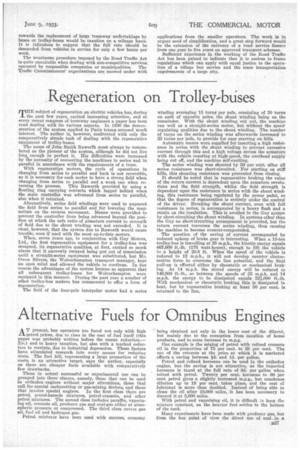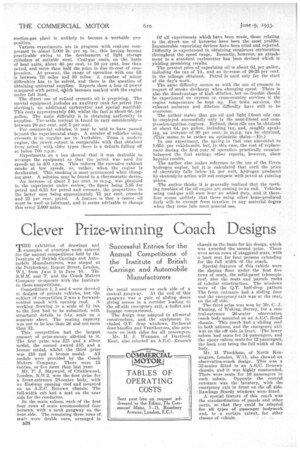Alternative Fuels for Omnibus Engines
Page 51

Page 52

If you've noticed an error in this article please click here to report it so we can fix it.
A'present, bus operators are faced not only with high petrol prices, due to sizes in the cost of fuel itself (this paper was probably written before the recent reduction.— Es.) and to heavy taxation, but also with a marked reduction in receipts, due to industrial depression. These factors have stimulated research into every means for reducing crests. The fuel bill, representing a large proportion of the costs, is an attractive target, says the author, especially as there are cheaper fuels available with comparatively few drawbacks.
Those in actual successful or experimental use can be grouped into three. classes, namely, those that can be used in orthodox engines without major alterations, those that call for special carburetting or gas-mixing devices, and those that involve special engines. In the first class there are petrol, petrol-benzole mixtures, petroLcreosote, and other petrol mixtures. The second class includes paraffin, vaporizing oil, creosote oil, producer gas and coal-gas either at atmospheric pressure or compressed. The third class covers gas oil, fuel oil and hydrogen gas.
Petrol mixtures have been used with success, economy being obtained not only in the lower cost of the diluent, but mainly due to the exemption from taxation of home products, and to some increase in m.p.g.
One example is the mixing of petrol with refined creosote oil in the proportion of 75 per cent. to 25 per cent. The use of the creosote at the price at which it is marketed effects a saving between id. and id. per gallon.
Petrol and refined kerosene can be used in the orthodox engine, but the saving is not attractive, as the imported kerosene is taxed at the full rate of 8d. per gallon when mixed with petrol. Twenty per cent. kerosene to 80 per cent. petrol gives a slightly increased m.p.g., but crankcase dilution up to 18 per cent. takes place, and the cost of lubricant is more than doubled. Instead of being able to clean the oil after 10,000 miles, it has been necessary to discard it at 5,000 miles.
With petrol and vaporizing oil, it is difficult to keep the mixture constant, as the heavier fuel settles to the bottom of the tank.
Many experiments have been made with producer gas, but from the bus point of view the direct use of coal .in a suction-gas plant is unlikely to become a workable proposition.
Verities experiments are in progress with coal-gas compressed to about 3.000 lb. per sq. in., this having become practicable owing •to the development of light storage cylinders of suitable steel. Coal-gas costs, on the basis a heat units, about 40 per cent. to 50 per cent, less than petrol, and more than half the price is due to cost of coinptession. At present, the range of operation with one fill is between 70 miles and 80 miles. A number of minor difficulties has to be solved, and there is the question of obtaining universal supplies. Reports show a loss of power compared with petrol, wjlich becomes marked with the engine under full load.
The direct use of refined creosote oil is promising. The special equipment includes an auxiliary tank for petrol (for starting), an additional carburetter and special manifold. This costs approximately £40, whilst the fuel is about 6d. per gallon. The main difficulty is in obtaining uniformity in supplies. Tar-acids content is found to vary considerably— between 20 per cent. and 5 per cent.
For commercial vehicles, it may be -said to have passed beyond the experimental stage. A number of vehicles using creosote is in regular use in Yorkshire. From a modern engine, the power output is comparable with that obtained from petrol ; with older types there is a definite falling off at below 700 r.p.m.
Experiments on a bus showed that it was desirable to arrange the equipment so that the petrol was used for speeds up to 400 r.p.m. This reduces the excessive exhaust smoke at low speeds, or, rather, when the engine is decelerated. This smoking is most pronounced when changing gear. A solution may be found in a thermostatic device.
An increase of about 7 per cent, in m.p.g. was obtained in the experiment under review, the figure being 5.85 for Petrol and 6.25 for petrol and creosote, the proportions in the latter case being approximately 75 per cent, creosote and 25 per cent. petrol. A feature is that a castor oil must be used as lubricant, and it seems advisable to change this every 2,000 miles. Of all experiments which have been made, those relating to the direct use of kerosene have been the most prolific. Innumerable vaporizing devices have been tried and rejected. Difficulty is experienced in obtaining consistent carburation throughout the speed range. Recently, however, an attachment to a standard carburetter has been devised which is yielding promising results.
The present price of vaporizing oil is about 6d. per gallon, Including the tax of Id., and an increase of 20-25 per cent, in the mileage obtained. Petrol is used only for the start of the days work.
The same difficulty occurs as with the use of creosote in respect of smoke discharge when changing speed. There is also the disadvantage of high dilution, but no trouble should be experienced on express or cross-country services if the engine temperature be kept up. For town services, the exhaust nuisance and dilution difficulty have still to be overcome.
The author states that gas oil and light Diesel oils can be employed successfully only in the semi-Diesel and compression-ignition engines. Refined, these oils can be obtained at about 6d. per gallon, including tax, and, roughly speaking, an increase of 90 per cent, in m.p.g. can be obtained. (This seems to be rather an optimistic claim.—En.) In one experiment, the saving in fuel cost amounted to 1.65d. per vehicle-mile, but, in this case, the cost of replacement during the first year of operation praeticallycounterbalanced the fuel saving ; other reports, however, show happier results.
The author also makes reference to the use of the Erren hydrogen engine, but it is calculated that until the price of electricity falls below id. per unit, hydrogen produced by electrolytic action will not compete with petrol at existing prices.
The author thinks it is generally realized that the teething troubles of the oil engine are coming to an end. Vehicles using coal-gas will soon bear an added duty, and it therefore seems unlikely that those using other home-produced fuels will be exempt from taxation to any material degree when they come into more general use.




























































































